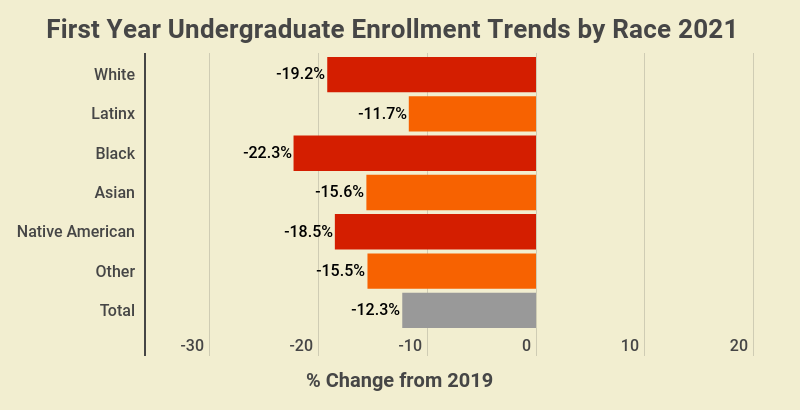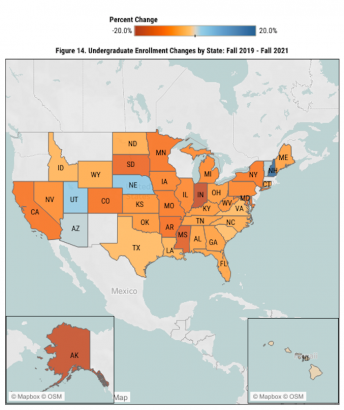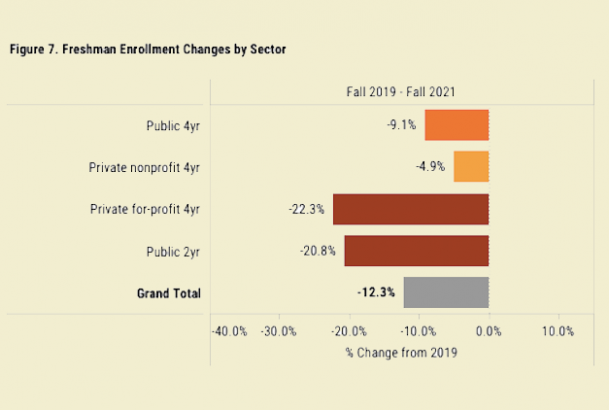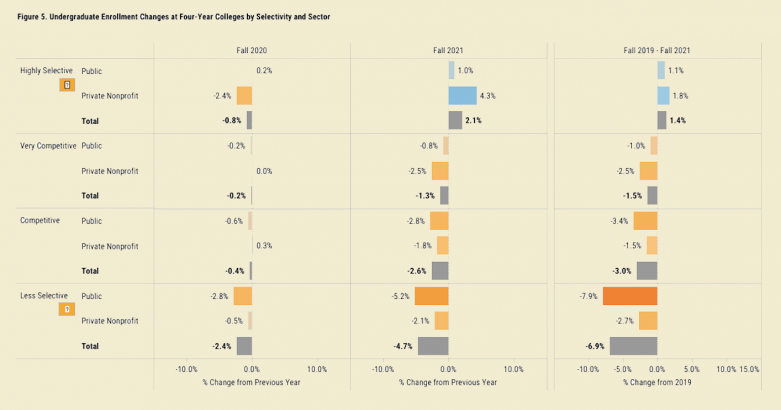‘No Signs of Recovery’: 5 Alarming New Undergraduate Enrollment Numbers

Get stories like these delivered straight to your inbox. Sign up for The 74 Newsletter
After the worst enrollment drop in a decade, colleges hoped COVID-19 vaccinations and in-person offerings would reel students back in.
But early fall undergraduate enrollment data suggest “no signs of recovery”, with the nation’s public universities historically serving low-income students of color hit hardest, according to the National Student Clearinghouse Research Center.
Across 2- and 4-year public and private nonprofit institutions, numbers continue to decline nationwide, now 6.5 percent below pre-pandemic 2019 levels.
And key public institutions, such as California’s Community Colleges, Pennsylvania’s State Universities, and the State University of New York system, are experiencing the worst declines.
First-year enrollment at community colleges for the 2021-22 academic year is 20.9 percent behind fall 2019. Total undergraduate enrollment at community colleges is 14.1 percent behind. In contrast, 4-year private nonprofit colleges experienced a 1.2 percent drop from 2019 to 2021.
Highly selective, elite schools are the only ones to rebound, netting gains in undergrad enrollment about 1.4 percent above fall 2019 levels.
Roughly 8.4 million students and 50 percent of higher education institutions are reflected in the National Student Clearinghouse’s report, which includes data collected through September 23. While subgroup trends may change as more institutions report, the research center doesn’t expect the overall picture to shift drastically.
Here are five key findings from the October report:
1. There are 6.5% fewer undergraduates enrolled this year than in 2019.

The declines seen last year have persisted. Overall enrollment has dropped 3.2 percent, following 2020’s 3.3 percent drop.
Four states saw declines higher than two times this national average: California, Indiana, Mississippi and West Virginia. New Hampshire saw more gains than any other state — the outlier now has 7.9 percent more undergraduates enrolled than in 2019.
2. 22.3% fewer Black first-years are enrolled than in 2019, the biggest decline of any ethnic/racial group.

When looking at total undergraduate enrollment, beyond just first-years, there are 11 percent fewer Black students enrolled than the year prior to the pandemic. COVID-19 disproportionately affected Black Americans, whose families experienced some of the highest death rates.
White and Native American or Indigenous students experienced the second and third highest declines.
12.7 percent fewer Native American or Indigenous undergraduate students are enrolled overall. However there are 21 percent more Native students, and 1 percent more Latino students, enrolled at private nonprofit universities than in 2019.
3. First-year classes are 12.3% smaller than pre-pandemic levels, and at community colleges, 20.8% smaller.

Public community colleges experienced the worst declines in freshman enrollment. Compared to all other institutions, they remain the most impacted sector, with overall enrollment declining 14.1 percent since the pandemic began. Their highest drops were from Black students (33.4 percent) and students aged 21-24 (21.4 percent).
4. Undergraduate programs have lost more men (9.3%) than women (5.3%) since 2019.

These declines have not been consistent across institution types — community colleges’ first-year classes saw women’s enrollment drop almost five times the rate of men, at a total of 10 percent.
Overall analysis from 2019 to 2021 shows more men have not enrolled in undergrad programs than women.
5. Less selective, public schools had higher declines than any other sector: 5.2% since last fall and 7.9% since the pandemic began.

More selective, private schools have been able to retain and recruit more students than their public, less selective peers. Many have also discussed some elite universities’ invested endowments grew larger during the pandemic, making the institutions more wealthy.
Public institutions’ starker declines may suggest barriers to college have been exacerbated by the pandemic, like financial and familial stressors.
Get stories like these delivered straight to your inbox. Sign up for The 74 Newsletter

;)
